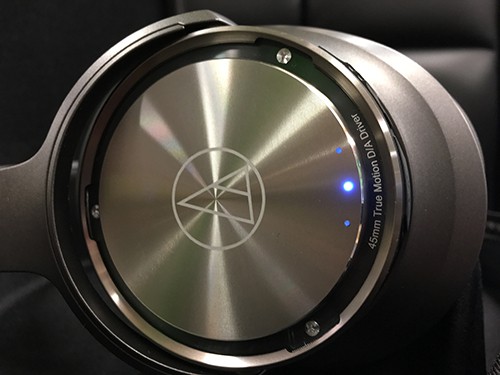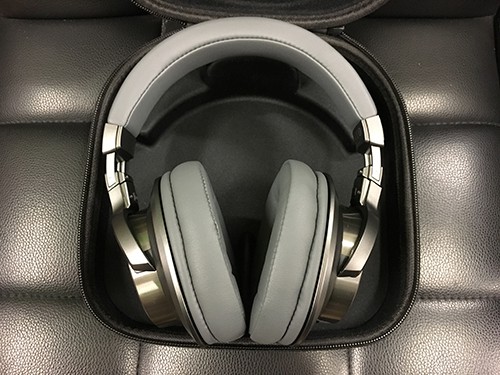It’s been only a week since the greatly anticipated Audio Technica ATH-SR9 headphone hit the streets and now the wireless version of this audiophile headphone is here for all the world to hear. It’s the Audio Technica ATH-DSR9BT wireless, over-ear headphone. The ATH-DSR9BT is truly a unique headphone because Audio Technica has set out to create the worlds best sounding wireless headphone. With a price point of just under $550 and without the usual features you tend to see in Bluetooth headphones, the ATH-DSR9BT could be a flop or a smashing success. Let’s take a close look with a full review.
Audio Technica ATH-DSR9BT Wireless Over-Ear Headphone Review
IN THE BOX
Unboxing the Audio Technica ATH-DSR9BT headphone you’ll find a simple set of premium accessories. Inside is the DSR9BT headphone (of course), a slim carrying case, a micro-usb charging wire and manuals / documents. One other handy thing in the package is the smaller case that fits inside the headphone case securely. This is for storing your charging cable neatly along with the headphone wherever you go.


BUILD & DESIGN
Design / Style
Like the ATH-SR9, the ATH-DSR9BT has no “throwback” or “retro” design about it. There’s no trendy leather headband or old school metallic earcup adjusting meachanism. The Audio Technica ATH-DSR9BT is here to represent the future of headphones and the minimal yet shiny and metallic grey design is a nice look for a headphone market lost in a sea of black, white and brown.
Durability / Portability / Comfort
The design of the ATH-DSR9BT headphone is one that demands respect with it’s ergonomic fit and fine electronics. The travel case included with this headphone is slim and can be taken discreetly to any event. The ATH-DSR9BT is designed as a high-end, everyday use headphone. The wireless connection feature combined with instant access to music and calls your smartphone. This means it’s very portable for what you get. And the comfort of the Audio Technica ATH-DSR9BT is luxurious from headband to earpads.
FEATURES
Pure Digital Drive
The main feature in this headphone that makes it different from others is something called Pure Digital Drive technology. This means that the digital ones and zeroes received by the wireless device inside this headphone remain in the digital domain all the way to the driver and then it’s converted to analog. It’s significant to note that when transferring digital audio via Bluetooth (v 4.2) or NFC the signal still remains digital from the source.

They Cut The Cable
Because of the Digital Drive technology, Audio Technica did something not many headphone manufacturers do when making wireless, over-ear headphones. To put it simply… they removed the aux audio jack. I think the tech wizards with Audio Technica figured if they’re going to use this ‘digital to analog’ technology properly they can’t go and give the listener the option to make it sound worse by plugging in a potentially noisy audio cable. Running an analog cable through this headphone would totally change the sound drastically in contrast to the direct digital signal. So to keep the high-resolution audio sounding pristine, Audio Technica “cut the cord” and kept quality control by utilizing a wireless digital audio receiver.
Direct Digital From Your Computer
There is a way to listen wired however. According to the manual, the ATH-DSR9BT can be connected to your computer (Windows or Mac OS X) to listen directly from your music player. This means you still get 100% clean digital signal to your headphone without adding unwanted noise. Setting this up is a little different for each computer and depends on the OS but it is a nice option. By connecting to your laptop while on a trip you’ll get great sounding audio without having to bother with Bluetooth or NFC. It’s also a nice option for listening in the office. You’ll save the DSR9BT battery for when you’re on the go.
No Noise-Cancelling, No Problem
The Audio Technica ATH-DSR9BT has no active noise cancelling feature and I’m quite alright with that. Many similarly priced wireless headphones also have an optional audio cable and noise-cancelling and people seem to love these features (though they don’t always understand what noise-cancelling is). It looks like Audio Technica is taking the lead on this new trend with the ATH-DSR9BT wireless over-ear headphone. The truth is that passive noise cancelling is well enough unless you happen to be listening to music in a construction zone. And if you want the best sound possible you don’t want to use active noise cancelling. It has the potential to alter the music output in undesirable ways. Plus you’ll also save on battery life by not having one more additional device draining your power. Definitely a good move by Audio Technica.
Wireless Connectivity
Bluetooth is a great standard for wireless device connection but it can be kind of tricky to get all the features you want to use in a Bluetooth approved product and still keep to data transfer flowing and connectivity solid. Audio Technica uses Bluetooth version 4.2 in the ATH-DSR9BT headphone and it seems to do the trick. Digital audio transmitted via Bluetooth arrives as clean as the original source via the receiver of the ATH-DSR9BT with no drop outs or glitches. I did notice that you must have line of sight with your transmitting device when moving away from the source device and 30ft seemed to be the limit. So if you’re listening to music on your headphones and walking into a nearby room, you’ll likely get drop outs as I did. Most wireless headphones have their distance limits and this is certainly a better than average result.
Digital Audio Formats / Battery Life
A few more notable features of the ATH-DSR9BT include its compatibility with Qualcomm aptX HD, aptX, AAC and SBC codecs, enabling wireless transmission with a resolution up to 24-bit/48kHz. The Audio Technica ATH-DSR9BT also boasts up to 15-hours battery life. Not bad for a wireless audiophile headphone. It’s also worth mentioning that the DSR9BT is capable of handling calls from your smartphone.
SOUND
Sound Signature
The ATH-DSR9BT is designed as a high resolution headphone with portability and low ohms in order to work wirelessly with “low output” mobile devices and players. And if you look at the specs for the ATH-SR9 and ATH-DSR9BT you’ll notice something quite interesting. Especially when you look at the frequency range. Both headphones claim a frequency range of 5Hz to 45,000Hz. That’s an incredible range for a wireless headphone. This says a lot about the overall sound signature goal Audio Technica has for the ATH-DSR9BT.
I tested the ATH-DSR9BT with streaming files from my phone as well as hi-resolution files from a dedicated player to hear the difference it makes overall. The result was amazing. Streaming files from Spotify sounded crisp, clean and full. Hi-res files like FLAC, ALAC and WAV were perfect. So lets break down the sound response by bandwidth to compare a little more.

Bass (20Hz – 250Hz)
The bass response on the Audio Technica ATH-DSR9BT headphone is surprisingly good. Compared to the wired SR9 it’s a lot more full and punchy. Perfect for pop, rock, hip-hop, electronic and any genres that need a little bass response to really get the emotion intended in the mastered tracks.
Mids (250Hz – 4kHz)
I had no complaint about the mids on the ATH-DSR9BT. In fact they were great, relatively flat and not overpowering in the upper mid-range frequencies.
Highs (4kHz – 20kHz +)
The high frequencies pushing out of the Audio Technica ATH-DSR9BT are clear as you would expect them to be. If you’ve ever listened to an Audio Technica ATH-MSR7 you’ll notice that the range on the SR9 and DSR9BT are higher than the well loved MSR7. And it’s not just in the specs. If you compare them side by side you’ll hear the difference. The high frequencies on the SR9 and DSR9BT a clearly more defined in the upper range. When using hi-res audio players with Bluetooth, getting fantastic CD quality (or higher) sound quality without wires… without a struggle
SUMMARY
After trying the new Audio Technica ATH-DSR9BT wireless headphone I immediately named it “A Brave New Wireless Headphone”. I call it “brave” because Audio Technica dared to make a high-end wireless headphone with no option to use a wire if the battery is dead. They also didn’t add the ever-popular active noise cancelling feature (which I think is overrated). Some people think this is crazy but I applaud Audio Technica for taking this leap. It may take a while but we’re most likely headed for a wireless high-fidelity headphone future and Audio Technica is already perfecting the craft. Based on the high quality sound for digital audio, excellent Bluetooth capabilities and the bold move of leaving out the cable and noise cancelling I’m giving the Audio Technica ATH-DSR9BT headphone the MajorHiFi Gold Award.
With all that being said, the Audio Technica ATH-DSR9BT wireless headphone had a more pleasing sound signature than the ATH-SR9 in my opinion. The very high frequencies were clean but not too bright and the bass was full and pleasing. The constraints of Bluetooth wireless standards have made it difficult to get hi-resolution audio and Audio Technica seems to have made it happen by simply focusing on the important things… a well built headphone, solid wireless connectivity and excellent sound. If you want one of the best over-ear wireless headphones in the world, choose the Audio Technica ATH-DSR9BT.
You can find the Audio Technica ATH-DSR9BT wireless headphone for the cheapest price at Audio46 using discount code “majorhifi” during checkout. The headphone is also available at a competitive price from authorized retailers on Amazon.


SPECIFICATIONS
Driver Type – Dynamic
Driver Diameter – 45 mm
Voice Coil – OFC-7N
Frequency Response – 5 Hz to 45,000 Hz
Sensitivity – 97 dB/mW
Impedance – 38 ohms
Battery Internal Battery: 3.7V rechargeable lithium polymer battery
Battery Life – Approx. 15 hours continuous use (1000 hours standby)
Charging Time: Approx. 5 hours (for 0-100% charge)
Depending on environmental conditions
Weight – 310 g (10.9 oz), without cable
Accessories Included – 2.0 m (6.6′) USB charging cable, hard carrying case
Type (Microphone) – condenser
Sensitivity (Microphone) -44 dB (1V/Pa a 1 kHz)
Frequency Response (Microphone) 50 – 4,000 Hz
Polar Pattern (Microphone) – omnidirectional
MAJORHIFI may receive commissions from retail offers.







